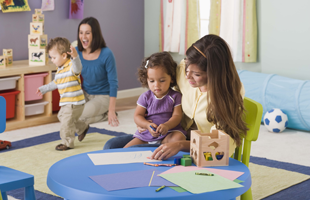Step 2 Implementing Graduated Guidance Prompting
![]()

The initial steps involved with using or implementing graduated guidance prompting are: get the toddler’s attention; and present the target stimulus, and the cue or task direction.
Step 2.1 Get the toddler’s attention
Once you get the toddler's attention, present the target stimulus, and the cue or task direction.
Step 2.2 Wait for the toddler to respond
After delivering the cue or task direction, pause and wait for the length the response interval for the toddler to begin the chained task or activity or routine on his own. The controlling prompt is not given until the response interval is over. The only exception would be if the toddler makes an incorrect response (see Step 2.4).
EXAMPLE
Charlie’s mom says, “time to clean up” and gives him his plate. She then waits 3 to 5 seconds, the specified response interval, for Charlie to start moving toward the kitchen counter.
The task direction is "time to clean up."
Step 2.3 Provide the controlling prompt to initiate the chained task
If the toddler does not respond after a short response interval, use the controlling prompt. The adult provides the amount and type of prompt needed to get the toddler to start performing the chain. As soon as the toddler begins to do the chain, adults reduce the intensity or amount of the prompt and start to shadow the toddler’s movements.
Shadowing is a term used to describe the action of holding your hands near the toddler’s hands so you can immediately guide the toddler to complete the behavior.
EXAMPLE
For Charlie, the controlling prompt was identified as hand-over-hand from behind so that Charlie would begin the chain by taking his plate and placing on kitchen counter.
 Video: Shadowing with a Toddler
Video: Shadowing with a Toddler
Step 2.4 Provide additional assistance if needed
Iif the toddler stops, responds incorrectly, or resists, provide additional assistance.
Review the following common challenges and solutions to graduated guidance:
Problem |
Possible Solution |
|
Toddler stops performing the chained step. |
The adult immediately provides the amount and type of prompt needed to get the movement started. |
|
Toddler begins to use the chained skill or behavior incorrectly. |
The adult immediately blocks that movement and provide the amount and type of prompt needed to get the toddler to do the chain correctly. |
|
Toddler resists the type of physical prompt. |
The adult should stop the movement and hold the toddler’s hands gently in place. When the resistance subsides, the adult assists the movement toward completing the step in chain again by applying the type of physical prompt needed. This may include reducing the intensity or location of the physical prompt. |
|
Toddler resists on the last step of the chain. |
The adult does not reinforce the toddler if there is resistance on the last step of the chain. This is to ensure that the toddler is reinforced for the correct behavior. Instead, the adult stops teaching the target skill/behavior until the toddler is no longer resistant. When the resistance subsides, the adult begins teaching the target skill/behavior from the beginning of the chain. |
|
Toddler consistently resists the prompt. |
Graduated Guidance many not be an appropriate approach for this skill or toddler. |
Step 2.5 Verbally praise and encourage the toddler as steps of the chain are completed

As the toddler correctly completes each step of the chain (prompted or unprompted), provide verbal praise and encouragement. At the end of the chain, provide reinforcement to the toddler for completing the task correctly.
Using Prompts with Graduated Guidance
Prompts should focus the toddler’s attention on the target stimulus, not distract from it.
When delivering prompts with Graduated Guidance:
-
Prompts should be as weak as possible.
-
Unplanned prompts should be avoided.
-
Prompts should be faded as quickly as possible.
-
The following are tips for fading prompts:
-
Fading should be determined by monitoring toddler’s unprompted and prompted correct responses
-
Reduce or fade prompts and/or increase the response interval or wait time gradually and systematically.
-
Reduce or fade prompts as quickly as it is determined that toddler is responding without the prompts.
-
If prompts are not faded, prompt dependency can develop. Prompt dependency occurs as result of using prompts when not needed.
Knowledge Check
Question:
What should adults do when they first begin to implement graduated guidance and teach the chained task?
Question:
Describe the key concepts of effective prompting.
Question:
After waiting for the toddler to respond (response interval) and giving the controlling prompt, the toddler initiates the chained activity, but stops.
How should the adult respond?
Question:
How should you respond when the toddler begins to incorrectly respond, use an incorrect behavior, or resists during the chain?
Practice Scenario: Using Graduated Guidance Prompting
The practice scenario will open in a new browser tab/window.
When you have finished reviewing,
return to the module and take the Knowledge Check.
Practice Scenario files:
Center-based Scenario: Caleb in a Center-based Setting


